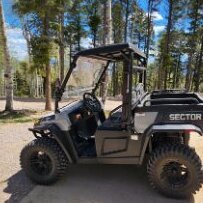No pressure in rear shocks
-
Similar Topics
-
By hdtran
That's the question! Or, if you want to add details:
(a) How do you use the UTV? (roads? off-road to get to trees? etc.)
(b) If you are wearing a helmet--how frequently? What type of helmet?
My own answers: (a) Most of the time off-road to get to downed trees, cut the trees to logs and haul the logs back for splitting. (b) Very rarely, a ski helmet and not a motorcycle helmet.
-
By Retired Plumber
The rear differential lock light is on and I would like to get it off. How do I do that it is a Coleman UTV700.
-
By djl
Hi All. The splines are pretty well worn where the rear driveshaft fits into the adapter (boss?) on the rear of the engine. I have a new driveshaft / adapter / seal to install but am having difficulty loosening the nut holding the adapter onto the transmission output shaft. I purchased a chain-type vice grip tool thinking that I could get it around the adapter to prevent it from turning but have not had any luck getting it in there yet (very tight space). What approaches have you used that have worked? Thanks!
-
By BOYD
I have a 2004 KUBOTA RTV 900 DIESEL and I need to replace both front cv axels.I have been online looking at them and there seems to be a lot of different manufactures to choose from. My question is who makes a good aftermarket set of cv axels for this KUBOTA. I have read horror stories of people buying the cheap Chinese brand only to find out they don't fit or they don't last very long and fail again. I hate to have to spend over $200 a shaft to get OEM from KUBOTA when I'm sure there is a company out there who probably makes it for them or makes comparable to OEM. Thanks for your help.
-







Recommended Posts
Join the conversation
You can post now and register later. If you have an account, sign in now to post with your account.
Note: Your post will require moderator approval before it will be visible.